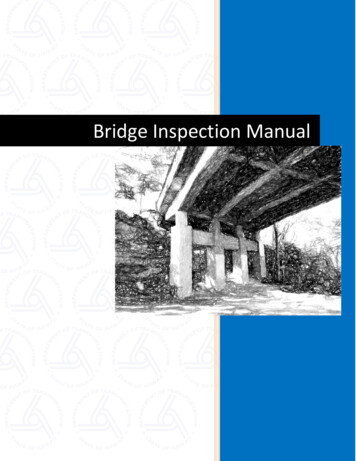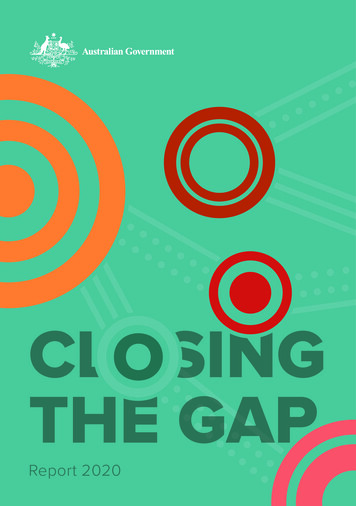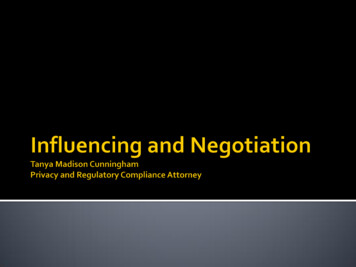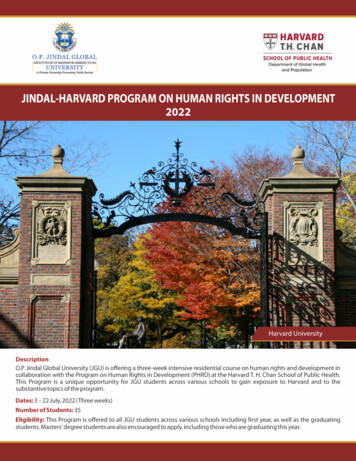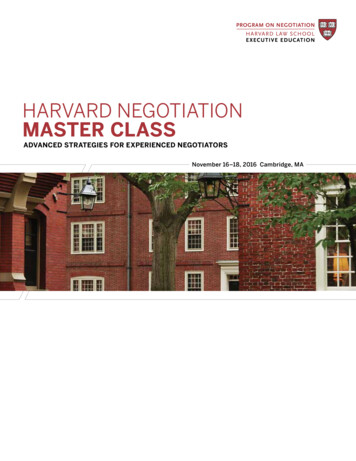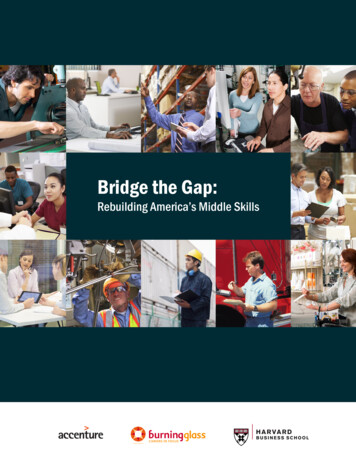
Transcription
Bridge the Gap:Rebuilding America’s Middle Skills
Executive Summary2Caught in the Middle4Mapping the Middle-Skills Landscape5Defining a Competitiveness-based Approach8Segmenting Middle-Skills Jobs9The Significance of Hard-to-Fill Jobs16Restarting America’s Middle-Skills Engine19RecommendationsEmployers: Invest in Talent Supply Chains20Educators: Build Effective Partnerships with Employers24Policymakers: Facilitate Communications and Data Sharing26Conclusion28Appendix I: Methodology: A Framework for UnderstandingOccupation Importance to U.S. Competitiveness29Appendix II: Methodology: A Framework for UnderstandingHard-to-Fill Jobs30Appendix III: Methodology for Accenture’s Middle-Skills Survey30Appendix IV: Methodology for HBS’ 2013–14 Alumni Survey30Appendix V: Initiatives Focused on Closing theMiddle-Skills Gap in America31Conflict of interest disclosureAccenture provides or may provide services to, partner with, or have other commercial or non-commercialinterests with organizations cited in this report.Burning Glass provides or may provide services to, partner with, or have other commercial or non-commercialinterests with organizations cited in this report. Burning Glass assumes no responsibility for other parties’ actionsconsequential to their reliance on any of the information contained herein.Bridge the Gap: Rebuilding America’s Middle Skills1
EXECUTIVE SUMMARYBusiness and civic leaders, educators, and policymakers of all stripes share concerns overthe relentless erosion of America’s middle class and growing polarization of incomes. Mostdecry the loss of middle-class jobs and fear the corrosive effects such trends might wreakon the nation if left unchecked. At the heart of the issue is an oft-discussed anomaly:while millions of aspiring workers remain unemployed and an unprecedented percentageof the workforce report being underemployed, employers across industries and regionsfind it hard to fill open positions. The market for middle-skills jobs—those that requiremore education and training than a high school diploma but less than a four-year collegedegree—is consistently failing to clear. That failure is inflicting a grievous cost on thecompetitiveness of American firms and on the standard of living of American workers.This market failure must be addressed. It is time we stopped accepting the cliché that America’s job engine isstalled. Today, business leaders have a promising opportunity to work with educators, policymakers, and laborleaders to spark a revival of middle-skills jobs. To accomplish that, they must radically rethink their businesses’roles in nurturing talent. This will also require employers to accept leadership over America’s system foreducating aspiring workers and bringing the unemployed back into the workforce.Historically, for innumerable Americans, middle-skills jobs served as the springboard into the middle class.Machinists and registered nurses, technical salespeople and computer technicians, financial analysts anda host of other jobs constituted the backbone of America’s workforce. Their productivity drove America’scompetitiveness. Over the past three decades, however, the United States steadily lost its capability to create andsustain enough jobs to support the realization of the American dream for millions of workers. Between 1979 and2000, real hourly wages for middle-skills workers stagnated; since then, wages have fallen.The powerful forces of globalization and technological innovation account for some of that decline. As thosechanges buffeted the economy, they also eroded the underpinnings of America’s once-effective workforcedevelopment system. In the face of that turbulence, too many businesses began relying on the “spot market”to fill their middle-skills needs instead of investing in workforce development efforts. Relationships betweenemployers and community colleges and other talent suppliers weakened. Educators burdened by budget cutsfocused on enrollment levels and graduation rates. As once-important employers stopped hiring and newerdisciplines emerged, educators found it harder to train students with relevant skills.Information deficiencies further plagued a system unused to addressing such a turbulent job market. Employershad little incentive to develop or share projections of their needs with educators, to incur the costs of definingqualifications on an industry-wide basis, or to invest in apprenticeships and cooperative education programs.Students and other aspiring workers had virtually no access to relevant information on which courses of study topursue, how to compare between entry-level jobs for their long-term career paths and wages, or which skills localbusinesses were seeking.The cumulative effects of those trends are now fully apparent in the United States. Underemployment is rampantfor both middle-skills workers and recent college graduates. Too few have highly marketable skills; too manyhave pursued courses of study for which there is little demand. Ballooning student debt threatens the future ofgraduates and looms over the federal budget. Employers find it hard to fill occupations ranging from healthcaretechnicians to technical sales and service. Companies cite fears about the availability of skilled labor as a majordeterrent to their growth plans. The current system is failing to serve the interests of employers and aspiringworkers alike.2
Despite the persistence of problems, no consensus has emerged on how to interdict this destructive cycle. Themajor stakeholders—business, educators, and policymakers—have consistently called for other players in thesystem to improve their performance, while attempting to improve their own results in isolation. So far, few havecollaborated to take collective action and restructure the broken system.We believe that U.S. competitiveness, broadly defined, provides alignment among different stakeholders inthe skills-development system. By applying the lens of competitiveness, we endeavor to show how the use ofinformation can improve outcomes for employers and workers. The first, essential step is to differentiate amongthe vast array of middle-skills jobs and concentrate on those with three important attributes: They create high value for U.S. businesses; They provide not only decent wages initially, but also a pathway to increasing lifetime career value formany workers; They are persistently hard to fill.The recent emergence of much more sophisticated jobs-market data allows businesses, educators, and studentsto overcome the impediments posed by the information deficiencies of the past. Vehicles now exist for employersto define, communicate, and update the competencies they are seeking to wide audiences. For example, ananalysis of current middle-skills job postings reveals jobs such as technical sales and sales management areboth more plentiful and more rewarding than those that receive significantly more attention in the nationaldialogue, such as advanced manufacturing occupations. As a result, students can relate the investment of timeand tuition dollars required to obtain a certification or degree to the associated earnings potential. Similarly,educators can redirect resources to developing training programs for better-paying jobs and where demand isgrowing.Our analysis underscores the need for leaders from the business, education, and political spheres to act inconcert to restore growth in America’s middle-skills ranks. Business leaders must champion an employer-led skills-development system, in which they bring thetype of rigor and discipline to sourcing middle-skills talent that they historically applied to their materialssupply chains. Educators must embrace their roles as partners of employers and help their students realize their ambitionsby being attentive to developments in the jobs market and the evolving needs of employers. Policymakers must actively foster collaboration between employers and educators, invest in improving publiclyavailable information on the jobs market, and revise metrics used by educators and workforce developmentprograms such that success is defined by placing students and workers in meaningful employment.All the stakeholders must also commit to contributing to a new conversation about work in America. Too often,our society’s leaders convey that a four-year college education is the only path to a respectable and rewardingcareer. That is not true. America’s competitiveness rests on the shoulders of its middle-skills workforce.Sustaining competitiveness will require a collective effort to restart America’s middle-skills engine.Bridge the Gap: Rebuilding America’s Middle Skills3
CAUGHT IN THE MIDDLEAmerica faces a pervasive and seemingly intractable skillschallenge. Well before the Great Recession, in the 1980sand 1990s, fissures began appearing between the skillsdemanded by American employers and the skills offeredby America’s labor force. The slow, jobless recovery thatfollowed the Great Recession reinforced how wide thechasm had grown over the last few decades.1 More than60 months after the recession officially ended in June 2009,the American economy remains mired in a disturbing skillstrap. Month after month, the U.S. labor force suffers a highunemployment rate, even as employers complain that jobopenings remain hard to fill. In August 2014, for example,the number of unemployed persons in America stood at9.6 million,2 with 4.8 million open job postings.3Economists, policymakers, labor unions, business leaders,and the media have all documented the mismatch in skillsfrom their unique perspectives and offered solutions. Yetdespite years of debate, America’s skills gap—especially forsolid, middle-skills jobs associated in the popular mind withthe American dream—refuses to shrink. Why is this so? Whydon’t employers, educators, and potential employees takemore decisive steps to end this misalignment? Who shouldtake the lead in bridging the gap?To probe these complex questions, the Harvard BusinessSchool launched a research initiative in 2013 in partnershipwith Accenture and Burning Glass Technologies. The threepartners shared a common interest in trying to shed newlight on the causes of the skills gap and, specifically, the rolebusiness could play in closing it.For HBS, this research marked a natural progressionin advancing our understanding of how to improveU.S. competitiveness. The School launched the U.S.Competitiveness Project in 2011 as a data-driven, nonpartisan effort to diagnose the strengths and weaknessesof the U.S. economy—and to identify measures businessleaders and policymakers could take to improve the nation’scompetitiveness. The research effort is guided by anoverarching definition, developed by HBS faculty members,of what constitutes U.S. competitiveness: “The United Statesis a competitive location to the extent that companiesoperating in the U.S. are able to compete successfully inthe global economy while supporting high and rising livingstandards for the average American.”4The first phase of HBS research in 2011, which covered 17elements of competitiveness, confirmed that America’s skillsissue was a critical factor undermining the U.S. economy(see Figure 1). Annual surveys of HBS alumni worldwideFIGURE 1: ASSESSMENT OF ELEMENTS OF THE U.S. BUSINESS ENVIRONMENT IN 2011U.S. trajectory compared to other advanced economies40%Weakness but ImprovingStrength and ImprovingUNIVERSITIESENTREPRENEURSHIP20%FIRM MANAGEMENTPROPERTY TIONCAPITAL MARKETSHIRING AND FIRING-20%-40%LEGAL FRAMEWORKSKILLED LABORREGULATION-60%MACRO POLICYLOGISTICS INFRASTRUCTURETAX CODEK–12 EDUCATION SYSTEM-80%-100%-60%POLITICAL SYSTEMStrength but DeterioratingWeakness and Deteriorating-40%-20%0%20%40%60%80%100%Current U.S. position compared to other advanced economiesNote: Scored as percentage with positive views minus percentage with negative views.Source: Michael E. Porter and Jan W. Rivkin, “Prosperity at Risk: Findings of Harvard Business School’s Survey on U.S. Competitiveness,” January 2012.4
consistently suggested that the skills of the Americanworkforce, once viewed as a source of competitiveness,were in decline relative to those of workers in otherdeveloped economies.5 The findings also implied that theperceived skills gap was influencing corporate decisionmaking. For example, HBS alumni involved in firm locationchoices reported that access to skilled labor was more oftena reason to move a business activity out of the United Statesthan it was a reason to keep an activity in America.6For Accenture, the initiative aligned with the company’slong-standing commitment to skills and employmentresearch; talent development for clients around the world;and its Skills to Succeed corporate citizenship initiative.Through Skills to Succeed, Accenture aims to equip, globally,700,000 people by 2015 with the skills to get a job or builda business. Accenture’s experience working with globalorganizations, researching talent and skills issues, andequipping people with skills that enable them to contributeto the economy was vital in understanding how to close themiddle-skills gap in the U.S.The partnership was greatly enhanced by Burning GlassTechnologies’ agreement to join the effort. A Boston-basedlabor market analytics firm, Burning Glass collects U.S.job postings from over 38,000 sources. The companyuses advanced proprietary text mining to read each jobdescription posted online. It is widely regarded as thedifferentiated source of real-time information about the U.S.labor market. Burning Glass generously provided accessto job-posting data from January 1 to December 31, 2013,allowing the entire team to analyze the middle-skills labormarket in terms of trends in specific jobs, experience,qualifications, and skills sought by employers.MAPPING THE MIDDLE-SKILLS LANDSCAPEThe authors of this report would like to start by gratefullyacknowledging the deep analysis and thoughtful researchundertaken by scholars and commentators on the middleskills gap. Our effort sought to build upon that existingresearch. We hope to contribute a framework that allowsleaders—most importantly business executives—tounderstand the competitive implications of the skills gapand to provide them with a set of specific and actionablerecommendations for addressing it.We began with a survey of the labor market. The basicdemographics of employment are widely known. Therecovery has proven a disappointment in terms of jobcreation when compared to previous rebounds. Broadermeasures of workforce demographics suggest widespreadunderemployment (see Figure 2 on Page 6).7While the nominal unemployment rate has fallen, muchof that apparent improvement has stemmed from workerstaking part-time positions. Historically, during recessionsit is usual for part-time employment to increase. However,this time, the persistence of high part-time employmenteven during the recovery is unusual. Longitudinal analysisshows that the recent recession registered a sharp spikein the number of part-time employed—peaking at 19.7% in2010, but still short of the all-time high of 20.3% in 1983.But what is more surprising is how long high part-timeemployment has lingered well into the recovery.8 By August2014, the rate had climbed up to 23%, well over the historichighs in the past.9The long-term unemployed have found it particularly difficultto reenter the workforce. Thirty percent of workers who wereunemployed long-term (27 weeks or more) between 2008and 2012, in follow-up interviews after 15 months, admittedthat they were still unemployed and looking for work.Another 34% had stopped looking for work altogether.10With each passing month away from work, worker skills andexperience erode and become more irrelevant.11The lethargy in the labor market applies to collegegraduates, too. Unemployment in recent college graduatesbetween 20 and 29 years of age and with Bachelor’sdegrees was 11.5% in October 2013, compared to 9.0%in October 2007.12 A study by the Federal Reserve Bank ofNew York also revealed the eroding quality of work securedby recent college graduates. More than 40% held jobsthat do not traditionally require a college degree; of thoseunderemployed graduates, almost 20% were working parttime and more than 20% were in low-wage jobs.13Perhaps most alarming has been the decline in workforceparticipation to a level not seen since the late 1970s.14Although a decline in participation has been forecast forsome time as the inevitable consequence of changingdemographics, recent research also suggests that it isbeing driven by the economics of employment.15 If potentialworkers cannot find employment that is more rewardingthan relying on public assistance or family and socialnetworks for support, they are less likely to continue toseek work.The extent and persistence of high levels of unemploymentand underemployment seem paradoxical in light ofemployers’ complaints about their inability to fill openpositions. We reviewed a range of studies that indicate thatcompanies nationwide continue to find it difficult to attracttalent with the requisite skills. They all tell a similar tale. Forexample, in a 2013 survey by Adecco, a workforce solutionsprovider in the United States and Canada, 92% of seniorBridge the Gap: Rebuilding America’s Middle Skills5
FIGURE 2: LABOR UNDERUTILIZATION (2008-2014)18%16%U-6 Rate14%12%10%U-3 Rate8%6%4%2008200920102011201220132014Source: Bureau of Labor Statistics, Current Population Survey.executives expressed the opinion that troubling gaps inskills plague the workforce. Nearly 44% of the executivesindicated that it was difficult to fill jobs because candidateslacked soft skills like communication and critical thinking.16Similarly, 49% of the respondents to Manpower Group’sTalent Shortage Survey in 2013 indicated that talentshortages were undermining their ability to servecustomers.17 Employers cited the absence of technical skills(48%) and of workplace or soft skills (33%) as the mostsignificant barriers to fulfilling their needs.18 Companies inthe U.S. can expect to feel the pinch even more severely inthe future as more than 76 million baby boomers age, andtheir current labor participation rate falls from 80% to below40% by 2022, typical of older age groups.19To deepen our understanding of the employer perspective,two partners of our team conducted new surveys, eachtargeting a unique audience. In a broad survey of 10,000HBS alumni between December 2013 and January 2014,HBS faculty unearthed very similar results to those providedby sources like Manpower. Some 38% of respondentsreplied that it was either very difficult or somewhat difficultto fill middle-skills positions, while only 26% indicated that itwas either very easy or somewhat easy to do so. HBS alumnifrom middle-sized companies20 found the task particularlychallenging, with 46% reporting that sourcing appropriatelyskilled talent was either very difficult or somewhat difficult.Accenture conducted a companion survey in February 2014of more than 800 human resources (HR) executives. Itdiscovered that 56% of respondents found middle-skills jobshard to fill, with finance and insurance (68%) and healthcare6(54%) companies experiencing the greatest challenges.Fully 69% of the overall sample and over 70% of the largestcompanies (those with revenues greater than 2 billion)indicated that their inability to attract and retain middleskills talent frequently affected their performance. Over onethird of respondents believed that inadequate availability ofmiddle-skilled workers had undermined their productivity,with manufacturing (47%) and healthcare (35%) thehardest hit.These data imply sobering consequences not only forcompanies, but also for new entrants to the workforceand the unemployed hoping to reenter the labor force.America’s education and workforce development systemsare just not producing a sufficient number of graduateswith skills relevant to today’s workplace and for jobs in highdemand. Employers are finding that the available talentfails to meet their standards. The data suggest that aspiringworkers cannot prudently assume that academic degrees orcertifications related to some desired career will necessarilylead to employment. If left unaddressed, the challenge forworkers to acquire and retain attractive middle-skills jobswill only worsen over time.The long-term evolution of the U.S. workforce is therefore asource of concern in more than one way. Over time, Americahas witnessed a gradual polarization of skills in the labormarket. The 1980s saw employment growth as well as wagegrowth for high-skill, high-wage jobs; the period from 1999to 2007 saw an increase in low-education, low-skill jobs,while middle-skills jobs and wages declined or remainedstagnant.21
Since 2000, “deskilling” has added further pressure onthe labor market as highly-educated, high-skilled workersmoved down the occupation ladder and took jobs historicallyheld by lower-skilled workers.22 In recent years, “malemployment,” in which workers are overeducated for theirjob, has been on the rise.23higher living standards. Accenture’s analysis of the U.S.labor market warns that trends such as an aging workforceand lower workforce participation rates could result in a9% decline in U.S. standards of living (per capita GDP inreal dollars) by 2030.26 To improve their lot, workers willtherefore have to rely on developing marketable skills.The growth in polarization transcends business cycles, butit has been demonstrated to accelerate dramatically duringrecessionary periods. One study suggests that it acceleratesat nearly six times the rate in recessions when comparedto periods of economic expansion.24 The polarization hasbecome more pronounced in the recent downturn. A reportfrom the National Employment Law Project (NELP) foundthat low-wage sectors, such as food services and retailtrade, accounted for only 22% of jobs lost during the GreatRecession but 44% of jobs gained since the beginning ofthe recovery. Mid-wage jobs accounted for 37% of lossesbut only 26% of gains; higher-wage jobs, 41% of losses butonly 30% of gains.25 While a recent NELP survey suggestsan uptick in hiring in higher-wage jobs, total employmentin middle- and high-paying jobs is 1.2 million jobs lowerthan before the recession. If this remains largely a “barbellshaped jobs recovery”—one with employment gains recordedat the top and bottom ends of the market—it will haveimportant implications for aspiring workers. The evolutionof the composition of the workforce does not provide anyassurance that workers can rely on a rising tide to enjoyBut that won’t be easy. The 2013–14 HBS alumni surveyon U.S. competitiveness revealed another troubling insight:employers appear reluctant to hire full-time workers if analternative presents itself. First, the survey showed, 46% ofrespondents agreed that their firms’ U.S. operations preferto invest in technology to perform work rather than hireor retain employees, while only 25% disagreed.27 Second,49% said that their firms preferred to rely on vendors toperform work that can be outsourced, while only 29%reported that their firms would rather hire additional workersand keep work in-house. Third, when choosing to hire,companies also indicated a distinct preference for relyingon part-timers. Companies that increased their reliance onpart-time workers over the past three years outnumberedthose that had reduced their proportion of part-timers bytwo to one (see Figure 3). This reluctance of employers tohire puts pressure on American workers in two ways. Toattract potential employers, workers must develop skillsthat are integral to companies’ strategies, and they mustdemonstrate the capacity to master new competencies astheir workplace evolves.FIGURE 3: APPROACHES TO HIRING DECISIONSYour firm prefers to invest in new technology to perform work rather than hire or retain R AGREENOR DISAGREE17%9%6% 4%SOMEWHAT STRONGLY N/A DO NOTDISAGREE DISAGREEKNOWYour firm prefers to rely on vendors that can be outsourced rather than hire additional THER AGREENOR DISAGREESOMEWHATDISAGREE9%4% 3%STRONGLY N/A DO NOTDISAGREEKNOWCompared to three years ago, your firm’s U.S. operations use part-time workers 20%49%MOREABOUT THE SAME10%9%13%LESS U.S. OPERATIONSESTABLISHED 3 YEARS AGODO NOTKNOWNote: Percentages do not sum to 100% because of rounding.Source: Harvard Business School 2013–14 Survey on U.S. Competitiveness.Bridge the Gap: Rebuilding America’s Middle Skills7
Where will U.S. workers get those skills? Ironically, not frommany of the employers who bemoan the lack of skilled jobapplicants. Only a minority of respondents to both the HBSand Accenture surveys indicated that their firms investedin skill-building for potential employees. For example, in theHBS survey, only 45% of the respondents said their firmsoffered internships or apprenticeships for middle-skills jobs.In the Accenture survey, just 22% of companies said theywould always consider bringing someone on who requiresadditional training when they’re having trouble filling arole. Even fewer small companies (14%), those with annualrevenues of less than 250 million, said they were willingand able to do so.28This apparently widespread unwillingness of manyemployers to take a more active hand in filling a skills gapthat many complain threatens their competitiveness struckour team as perplexing. During the course of this research,when we asked employers about it, we found many believedthat their firms could avoid the negative consequences ofthe skills gap, despite knowing that their industry sufferedfrom one. They believed they would continue to attractthe talent, even while predicting an enduring shortage inthe general marketplace. We hope this report helps morebusinesses become self-aware about the need to invest inmiddle-skills development—not just for their own immediateneeds but for building a long-term pool of skills for theregion, industry, and community.DEFINING A COMPETITIVENESS-BASED APPROACHDespite the mass of impressive scholarly work on themiddle-skills gap, the issue had not been viewed through thelens of competitiveness. We believe that using the expansivedefinition of competitiveness, employed in the broader HBSresearch on the U.S. economy, might reveal how businessleaders, educators, and policymakers should go aboutaddressing the skills gap—and where they ought to focustheir attention.To begin that analysis, we probed if the broad and elasticdefinition of “middle skills” in fact stood in the way ofdeveloping strategies to close the skills gap. The standarddefinition of a middle-skills job—one requiring more thana high school diploma and less than a four-year collegedegree—encompasses a huge array of occupations. BurningGlass reported almost 7.3 million online postings29 formiddle-skills jobs in 2013, out of a total of 19.9 milliononline postings.30 In a typical month, approximately 600,000postings come online for middle-skills jobs. Those jobsrange considerably in terms of average compensationand the time required to earn the credentials. As Figure 4illustrates, middle-skills jobs are as diverse as those whohold them,31 differing widely in their average compensation,the education and training required beyond a high schooldegree, and the content of work itself.FIGURE 4: THE SCOPE OF MIDDLE SKILLS: AVERAGE SALARY AND EXPECTED QUALIFICATIONS 80,000Occupation Family 70,000Business/financeAverage Salary (BLS)Management 60,000Installation,maintenance,and repair 50,000HealthcareSales and related 40,000Transportation/material movingProduction 30,000 1415Average Years of Education/Training Advertised in PostingsSources: Bureau of Labor Statistics, 2012 Occupational Employment Statistics dataset;Burning Glass Technologies’ database of online job postings for 2012.816OnlineMiddle-SkillsPostings (2012)Sales and related1,910,430Office/admin material moving611,205Installation,maintenance and repair446,637Production363,544Information 148,029
To understand the impact on U.S. competitiveness, wetherefore needed to understand the attributes of middleskills jobs at a more granular level. Specifically, we wantedto understand how the middle-skills gap affected the UnitedStates’ ability to achieve the twin objectives of being a basefrom which firms can compete successfully in the globaleconomy while supporting high and rising living standardsfor the average American. If the skills gap is a threat toAmerica’s ability to support globally competitive enterprises,it must be felt in specific jobs that are crucial to firms’performance. Which middle-skills jobs meet that standard,and are they, in fact, hard for employers to fill? If the gap isa threat to the living standards of average Americans, wewanted to understand whether middle-skills positions stilloffer American workers the opportunity to enjoy high andrising living standards. Or has the polarization of Americaprogressed so far that most workers with middle skills arecondemned to stagnant or declining living standards?By analyzing those questions, we hoped to developsome insight about what leaders of all stripes, but mostimportantly business leaders, can do to start reducing theskills gap.SEGMENTING MIDDLE-SKILLS JOBSExploring the implications of the middle-skills gap forcompetitiveness required us to develop a tool for describingjobs in terms of two major variables: their importance tothe strategic success of American companies and theircapacity to support high and improving standards of livingfor someone holding that job. We developed the frameworkbelow, mapping those two variables along Y- and X-axes(see Figure 5). The “Value to U.S. Business” axis d
America faces a pervasive and seemingly intractable skills challenge. Well before the Great Recession, in the 1980s and 1990s, fissures began appearing between the skills demanded by American employers and the skills offered by America's labor force. The slow, jobless recovery that followed the Great Recession reinforced how wide the



